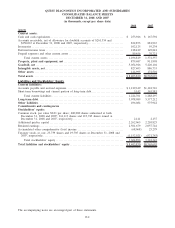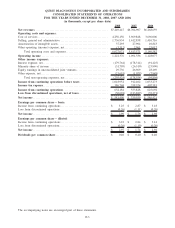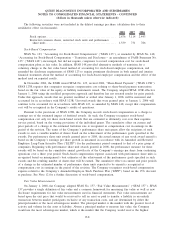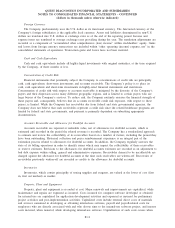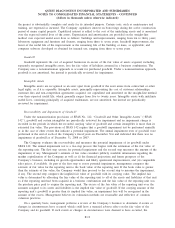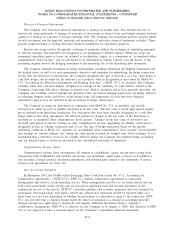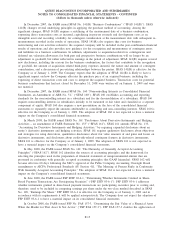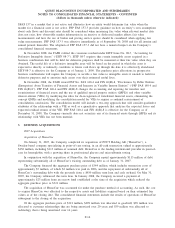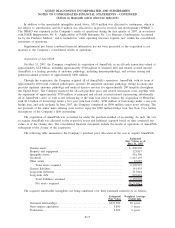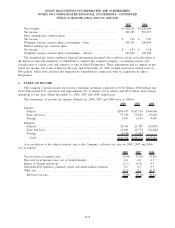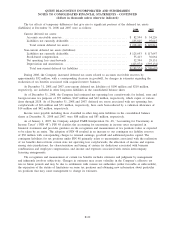Quest Diagnostics 2008 Annual Report Download - page 82
Download and view the complete annual report
Please find page 82 of the 2008 Quest Diagnostics annual report below. You can navigate through the pages in the report by either clicking on the pages listed below, or by using the keyword search tool below to find specific information within the annual report.The Company offers certain employees the opportunity to participate in a supplemental deferred
compensation plan. A participant’s deferrals, together with Company matching credits, are invested in a variety of
participant-directed stock and bond mutual funds as well as Company common stock and are classified as trading
securities. Changes in the fair value of these securities are measured using quoted prices in active markets based
on the market price per unit multiplied by the number of units held exclusive of any transaction costs. A
corresponding adjustment for changes in fair value of the trading securities is also reflected in the changes in fair
value of the deferred compensation obligation. The deferred compensation liabilities are classified within Level 2
because their inputs are derived principally from observable market data by correlation to the trading securities.
In connection with the acquisition of AmeriPath Group Holdings, Inc. (“AmeriPath”) in May 2007, the
Company assumed a non-qualified deferred compensation program AmeriPath offers to certain employees. A
participant’s deferrals, together with Company matching credits, are “invested” at the direction of the employee in
a hypothetical portfolio of investments which are tracked by an administrator. The Company purchases life
insurance policies, with the Company named as beneficiary of the policies, for the purpose of funding the
program’s liability. Changes in the cash surrender value of the life insurance policies are based upon earnings
and changes in the value of the underlying investments. Changes in the fair value of the deferred compensation
obligation are derived using quoted prices in active markets based on the market price per unit multiplied by the
number of units. The cash surrender value and the deferred compensation obligations are classified within Level
2 because their inputs are derived principally from observable market data by correlation to the hypothetical
investments.
The fair value measurements for available-for-sale securities are based upon the quoted price in active
markets multiplied by the number of shares owned exclusive of any transaction costs and without any
adjustments to reflect discounts that may be applied to selling a large block of the securities at one time. The
Company does not believe that the changes in fair value of these assets will materially differ from the amounts
that could be realized upon settlement or that the changes in fair value will have a material effect on the
Company’s results of operations, liquidity and capital resources.
The fair value measurements of foreign currency forward contracts are obtained from a third-party pricing
service. The fair value measurements of the Company’s interest rate swaps are model-derived valuations as of a
given date in which all significant inputs are observable in active markets including certain financial information
and certain assumptions regarding past, present and future market conditions. The Company does not believe that
the changes in the fair values of its foreign currency forward contracts and interest rate swaps will materially
differ from the amounts that could be realized upon settlement or maturity or that the changes in fair value will
have a material effect on its results of operations, liquidity and capital resources.
SFAS No. 159, “The Fair Value Option for Financial Assets and Financial Liabilities” (“SFAS 159”) became
effective for the Company on January 1, 2008. SFAS 159 provides companies with an option to irrevocably elect
to measure certain financial assets and financial liabilities at fair value on an instrument-by-instrument basis with
the resulting changes in fair value recorded in earnings. The objective of SFAS 159 is to reduce both the
complexity in accounting for financial instruments and the volatility in earnings caused by using different
measurement attributes for financial assets and financial liabilities. As of January 1, 2008 and for the period
ended December 31, 2008, the Company has elected not to apply the fair value option to any of its financial
assets or financial liabilities on-hand, which were not already measured at fair value, because the Company does
not believe that application of SFAS 159’s fair value option is appropriate, given the nature of its business
operations.
The carrying amounts of cash and cash equivalents, accounts receivable and accounts payable and accrued
expenses approximate fair value based on the short maturities of these instruments. In accordance with the
provisions of SFAS No. 107, “Disclosures About Fair Value of Financial Instruments” at December 31, 2008 and
December 31, 2007, the fair value of the Company’s debt was estimated at $2.9 billion and $3.6 billion,
respectively, using quoted market prices and yields for the same or similar types of borrowings, taking into
account the underlying terms of the debt instruments. At December 31, 2008, the carrying value exceeded the
estimated fair value of the debt by $155 million and at December 31, 2007, the estimated fair value exceeded the
carrying value of the debt by $59 million.
F-10
QUEST DIAGNOSTICS INCORPORATED AND SUBSIDIARIES
NOTES TO CONSOLIDATED FINANCIAL STATEMENTS - CONTINUED
(dollars in thousands unless otherwise indicated)




